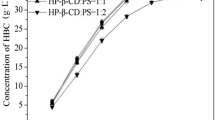Abstract
To enhance the efficiency of 22-hydroxy-23,24-bisnorchol-4-ene-3-one (HBC) production at high substrate concentrations, the cyclodextrin-resting cell system was used for the bioconversion of phytosterols (PS) in this study. Two intermediates, identified as 4-ene-3-keto steroids and 27-hydroxy-4-ene-3-keto steroids, were accumulated at the early stage of the bioconversion and related to the oxygen bioavailability. We demonstrated that oxygen bioavailability was the main rate-limited factor at high substrate concentrations in the reaction system. Measures improving oxygen transfer rate in the reaction system significantly enhanced the bioconversion efficiency of PS to HBC with a space–time yield of 13.25 g/L/day.
Graphical Abstract







Similar content being viewed by others
References
Xu LQ, Liu YJ, Yao K et al (2016) Unraveling and engineering the production of 23,24-bisnorcholenic steroids in sterol metabolism. Sci Rep 6(1):21928
Hu Y, Wang D, Wang XD et al (2020) A recycled batch biotransformation strategy for 22-hydroxy-23,24-bisnorchol-4-ene-3-one production from high concentration of phytosterols by mycobacterial resting cells. Biotechnol Lett 42(12):2589–2594
Gao XQ, Feng JX, Hua Q et al (2014) Investigation of factors affecting biotransformation of phytosterols to 9-hydroxyandrost-4-ene-3,-17-dione based on the HP-β-CD-resting cells reaction system. Biocatal Biotransform 32(5–6):343–347
El-Refai H, Abd-Elslam IS (2020) Enhancement of β-sitosterol bioconversion by Fusarium solani using aqueous-organic solvent system. Aust J Basic Appl Sci 4:4107–4112
Hesselink PGM, Van Vliet S, De Vries H et al (1989) Optimization of steroid side chain cleavage by Mycobacterium sp. in the presence of cyclodextrins. Enzyme Microb Technol 11(7):398–404
Jambhekar SS, Breen P (2016) Cyclodextrins in pharmaceutical formulations II: solubilization, binding constant, and complexation efficiency. Drug Discov Today 21(2):363–368
Mancilla RA, Little C, Amoroso A (2018) Efficient bioconversion of high concentration phytosterol microdispersion to 4-androstene-3,17-dione (AD) by Mycobacterium sp. B3805. Appl Biochem Biotechnol 185(2):494–506
Yuan JJ, Guan YX, Yao SJ (2017) Evaluation of biocompatible ionic liquids for their application in phytosterols bioconversion by Mycobacterium sp. resting cells. ACS Sustain Chem Eng 5(11):10702–10709
Donova MV, Nikolayeva VM, Dovbnya DV et al (2017) Methyl-beta-cyclodextrin alters growth, activity and cell envelope features of sterol-transforming mycobacteria. Microbiology 153(Pt 6):1981–1992
Fernandes P, Cruz A, Angelova B et al (2003) Microbial conversion of steroid compounds: recent developments. Enzyme Microb Technol 32(6):688–705
Manosroi A, Saowakhon S, Manosroi J (2008) Enhancement of androstadienedione production from progesterone by biotransformation using the hydroxypropyl-β-cyclodextrin complexation technique. J Steroid Biochem Mol Biol 108(1):132–136
Shtratnikova VY, Schelkunov MI, Dovbnya DV et al (2017) Effect of methyl-β-cyclodextrin on gene expression in microbial conversion of phytosterol. Appl Microbiol Biotechnol 101(11):4659–4667
Yao K, Wang FQ, Zhang HC et al (2013) Identification and engineering of cholesterol oxidases involved in the initial step of sterols catabolism in Mycobacterium neoaurum. Metab Eng 15:75–87
Sun H, Yang J-L, He K et al (2021) Enhancing production of 9α-hydroxy-androst-4-ene-3,17-dione (9-OHAD) from phytosterols by metabolic pathway engineering of mycobacteria. Chem Eng Sci 230:116195
Donova MV, Egorova OA (2012) Microbial steroid transformations: current state and prospects. Appl Microbiol Biotechnol 94(6):1423–1447
Giorgi V, Menéndez P, García-Carnelli C (2019) Microbial transformation of cholesterol: reactions and practical aspects—an update. World J Microbiol Biotechnol 35(9):131
Casabon I, Swain K, Crowe Adam M et al (2014) Actinobacterial acyl coenzyme A synthetases involved in steroid side-chain catabolism. J Bacteriol 196(3):579–587
Shao ML, Zhang X, Rao ZM et al (2019) Identification of steroid C27 monooxygenase isoenzymes involved in sterol catabolism and stepwise pathway engineering of Mycobacterium neoaurum for improved androst-1,4-diene-3,17-dione production. J Ind Microbiol Biotechnol 46(5):635–647
Yang M, Lu R, Guja KE et al (2015) Unraveling cholesterol catabolism in Mycobacterium tuberculosis: ChsE4-ChsE5 α2β2 acyl-CoA dehydrogenase initiates β-oxidation of 3-oxo-cholest-4-en-26-oyl CoA. ACS Infect Dis 1(2):110–125
Zhao AQ, Zhang XQ, Li YM et al (2021) Mycolicibacterium cell factory for the production of steroid-based drug intermediates. Biotechnol Adv 53:107860
Wang D, Zhang J, Cao D-D et al (2021) Identification and in situ removal of an inhibitory intermediate to develop an efficient phytosterol bioconversion process using a cyclodextrin-resting cell system. RSC Adv 11(40):24787–24793
Acknowledgements
This work was supported by the National Natural Science Foundation of China (grant numbers 31570079, 21276083).
Author information
Authors and Affiliations
Corresponding authors
Ethics declarations
Conflict of interest
The authors declare that they have no conflict of interest.
Additional information
Publisher's Note
Springer Nature remains neutral with regard to jurisdictional claims in published maps and institutional affiliations.
Supplementary Information
Below is the link to the electronic supplementary material.
Rights and permissions
About this article
Cite this article
Han, Y., Zhu, X., Wang, X. et al. Oxygen Bioavailability is a Rate-Limited Factor in Phytosterols Bioconversion Using a Cyclodextrin-Resting Cell System. Catal Lett 153, 1557–1563 (2023). https://doi.org/10.1007/s10562-022-04090-4
Received:
Accepted:
Published:
Issue Date:
DOI: https://doi.org/10.1007/s10562-022-04090-4




